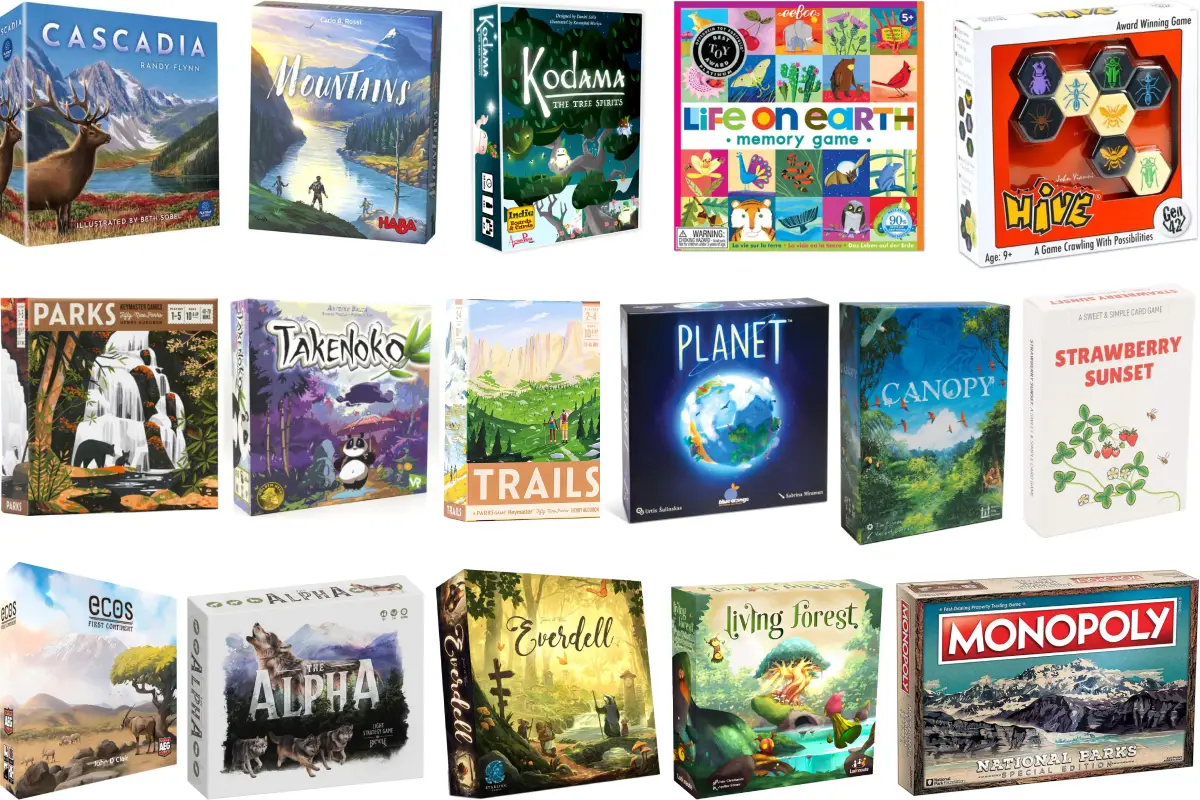This post contains affiliate links.
Studies show that children excel in science in school when they understand nature. So aside from traveling and playing outside, why not try playing nature-themed board and card games?
I found 11 board games and 6 card games that can help children be familiar with
- Natural habitats like Cascadia
- Animals such as Everdell
- US National Parks, for example, Mountains
- Trees like Arboretum
- Tree-building such as Kodama
- Gardening like Strawberry Sunset
Nature-themed Board and Card Games Comparison Table
The following board and card games can make science interesting for children. I included the theme, age recommendation, and player count for quick reference.
| Game | Type | Theme | Age | Players | For | Price | Rating |
| Cascadia | Puzzle | Habitat | 10+ | 1-4 | Families | $$$ | ★★★★☆ |
| Ecos: The First Continent | Board | Habitat | 14+ | 2-6 | Families | $$$ | ★★★★☆ |
| Planet | Board | Habitat | 8+ | 2-4 | Families | $$ | ★★★☆☆ |
| Living Forest | Board | Tree-building | 8+ | 2-4 | Families | $$$ | ★★☆☆☆ |
| The Alpha | Board | Animals | 10+ | 3-6 | Families | $$$ | ★★★☆☆ |
| Everdell | Board | Animals | 13+ | 1-4 | Families | $$$$ | ★★★☆☆ |
| Hive | Board | Insects | 9+ | 2 | Families | $$$ | ★★★☆☆ |
| Takenoko | Board | Bamboo | 8+ | 2-4 | Families | $$$ | ★★★☆☆ |
| Monopoly National Parks | Board | US Parks | 8+ | 2-6 | Families | $$$ | ★★★★☆ |
| Mountains | Board | US Parks | 8+ | 1-5 | Families | $$ | ★★☆☆☆ |
| Trails | Card | US Parks | 10+ | 2-4 | Families | $$ | ★★★☆☆ |
| Parks | Card | US Parks | 10+ | 1-5 | Families | $$$$ | ★★★☆☆ |
| Life on Earth | Card | Living Things | 3+ | 1-4 | Families | $$ | ★★☆☆☆ |
| Arboretum | Card | Greenhouse | 8+ | 2-4 | Families | $$ | ★★★☆☆ |
| Canopy | Card | Rainforest | 8+ | 1-4 | Families | $$ | ★★★☆☆ |
| Kodama | Card | Tree-building | 14+ | 2-5 | Families | $$ | ★★☆☆☆ |
| Strawberry Sunset | Card | Gardening | 7+ | 1-4 | Families | $$ | ★★★☆☆ |
Habitat-Building Board Games
Cascadia (Alderac Entertainment Group)
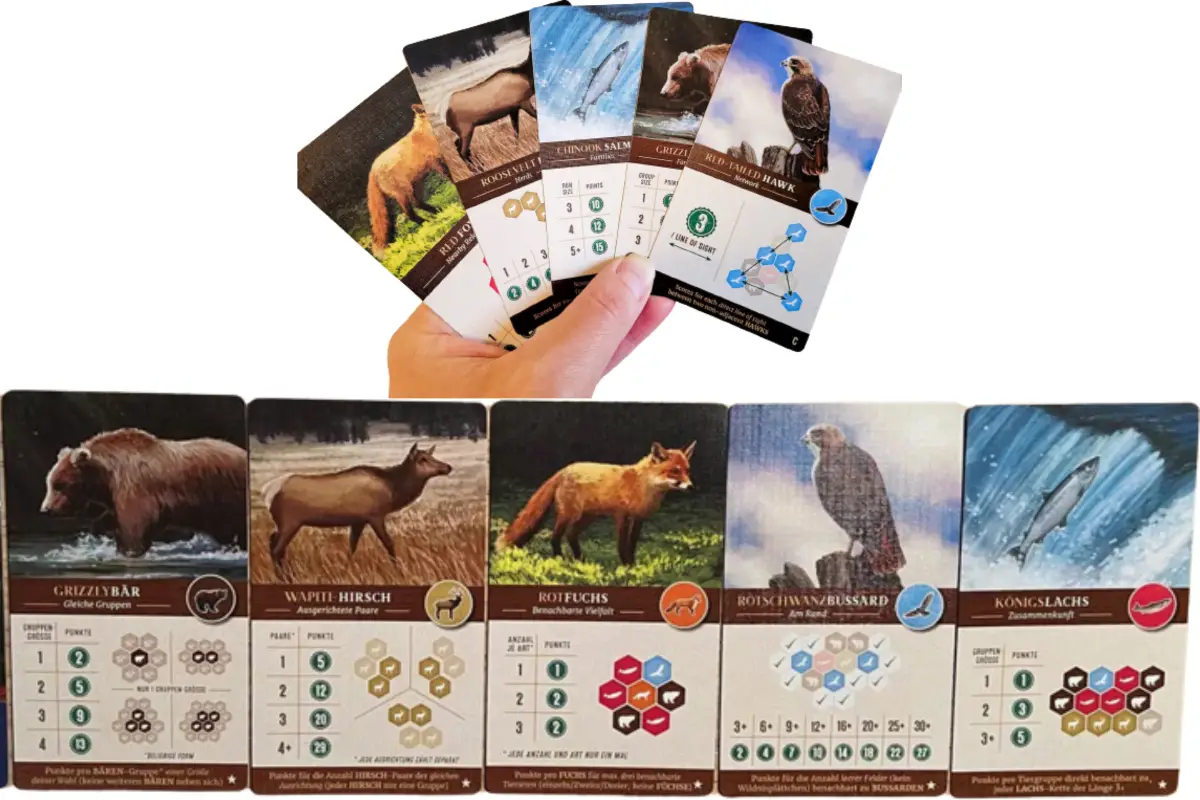
★★★★☆
For Families | Age: 10+ | 1-4 Players | Game Duration: 30-45 minutes| Designer: Randy Flynn
In Cascadia , children learn about 5 different types of habitats: rivers, wetlands, forests, prairies, and mountains and the wildlife animals that thrive in them.
, children learn about 5 different types of habitats: rivers, wetlands, forests, prairies, and mountains and the wildlife animals that thrive in them.
Players connect habitat tiles and place wildlife tokens equal to the requirements on animal cards during play. The player with the largest grouping of connected tiles for each habitat type wins the game.
The pros of this puzzle game include:
- It is easy to play and set up
- Has scoring variants: family and intermediate
- Sturdy game components which are great for multiple uses
I recommend Cascadia because the components use real images of nature and wildlife.
because the components use real images of nature and wildlife.
This video of Dice Tower gives you a game overview of Cascadia.
Ecos: The First Continent (Alderac Entertainment Group)
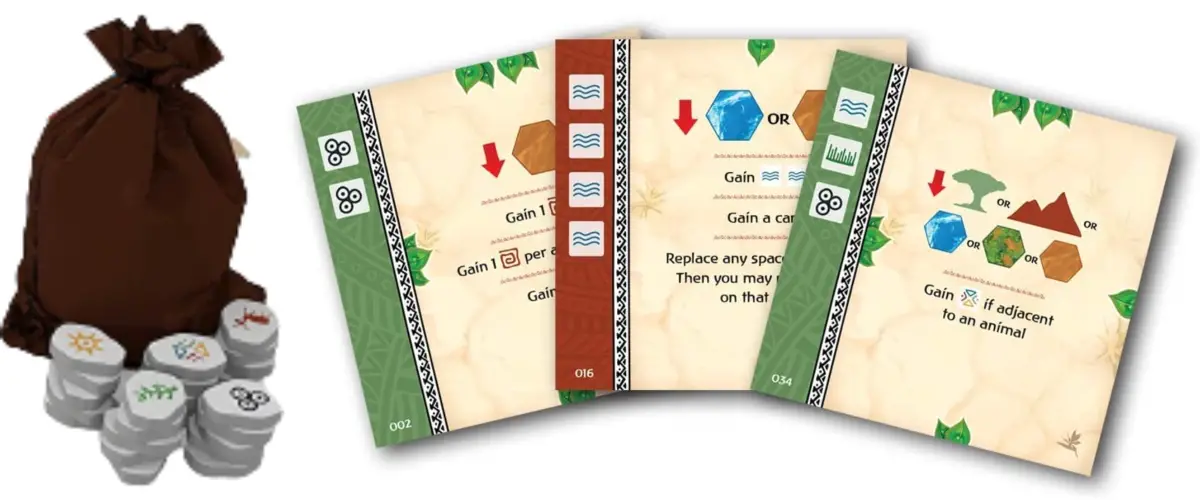
★★★★☆
For Families | Age: 14+ | 2-6 Players | Game Duration: 45-75 minutes| Designer: John D’ Clair
In Ecos: The First Continent , players score points as they shape their own continent by putting together different habitats and species. This game has map tiles, dial tokens, 105 cards, and wooden tokens for elements, animals, mountains, forests, and energy cubes.
, players score points as they shape their own continent by putting together different habitats and species. This game has map tiles, dial tokens, 105 cards, and wooden tokens for elements, animals, mountains, forests, and energy cubes.
The goal is to score 80 points before another player does. The first person to reach the goal wins.
I recommend this game because:
- it is easy to learn and play (most enjoyable with 2 players)
- encourages player interaction
- Has game variants that are clearly explained in the rulebook
- It teaches players what types of animals thrive in different habitats
- The tokens are easy to organize and store
- Scoring is easy because of the scoring cubes and scoreboard
You can learn more about its gameplay in this review by GameboyGeek.
Planet (Blue Orange Games)
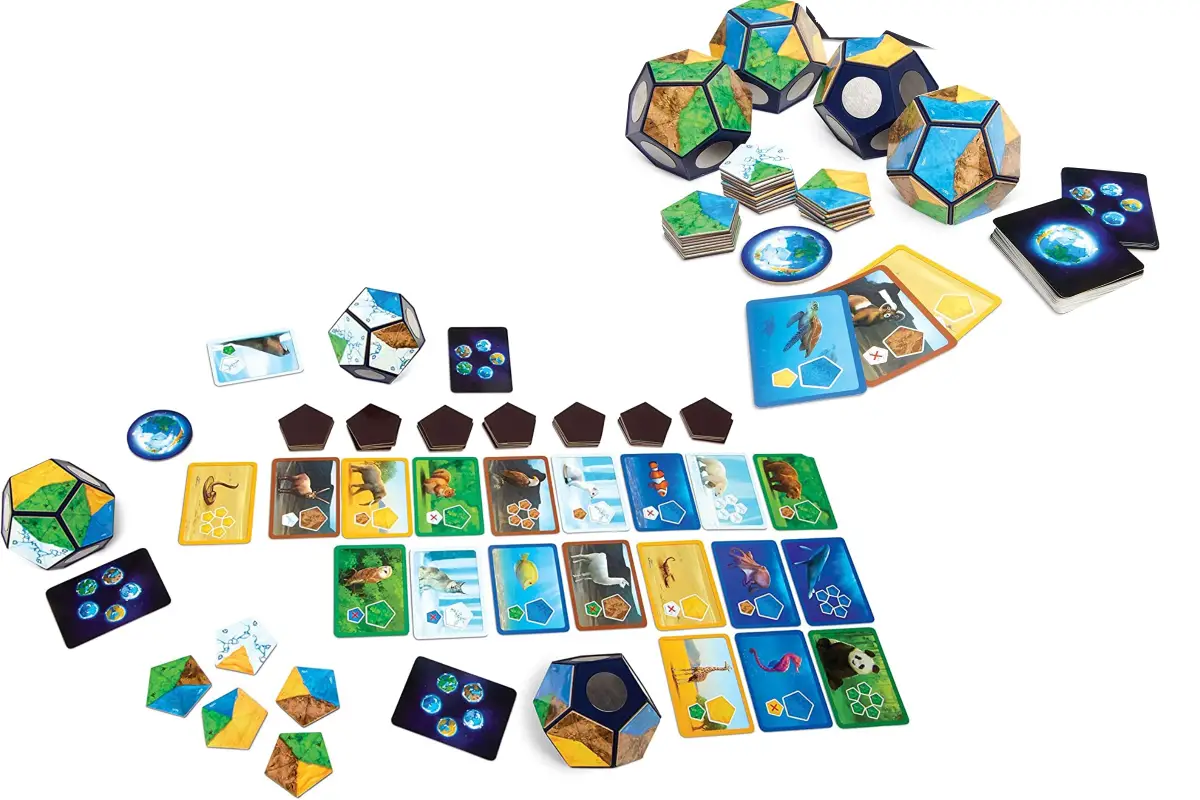
★★★☆☆
For Families | Age: 8+ | 2-4 Players | Game Duration: 30-45 minutes| Designer: Urtis Sulinskas
Planet is a tile-placement game where players aim to complete their planet core within 12 turns. The set has:
is a tile-placement game where players aim to complete their planet core within 12 turns. The set has:
- 4 planet cores
- 50 continent tiles with illustrations of mountains, glaciers, forests, oceans, and deserts
- 45 animal cards
- 5 natural habitat objective cards
Each player receives a planet core. They take turn attaching continent tiles onto their planet core based on the conditions on the natural habitat cards. Then, they populate these habitats by winning animal cards.
I recommend Planet because it stimulates children to explore their imagination to create a perfect world. The components are durable and easy to use. Children will be fascinated to hold the planet core because the tiles fit nicely.
because it stimulates children to explore their imagination to create a perfect world. The components are durable and easy to use. Children will be fascinated to hold the planet core because the tiles fit nicely.
The images on the cards are great, but could be improved with names and interesting information about the animals.
Here’s a demonstration and review of Planet by Tom Vasel.
by Tom Vasel.
Living Forest Board Game (Asmodee)
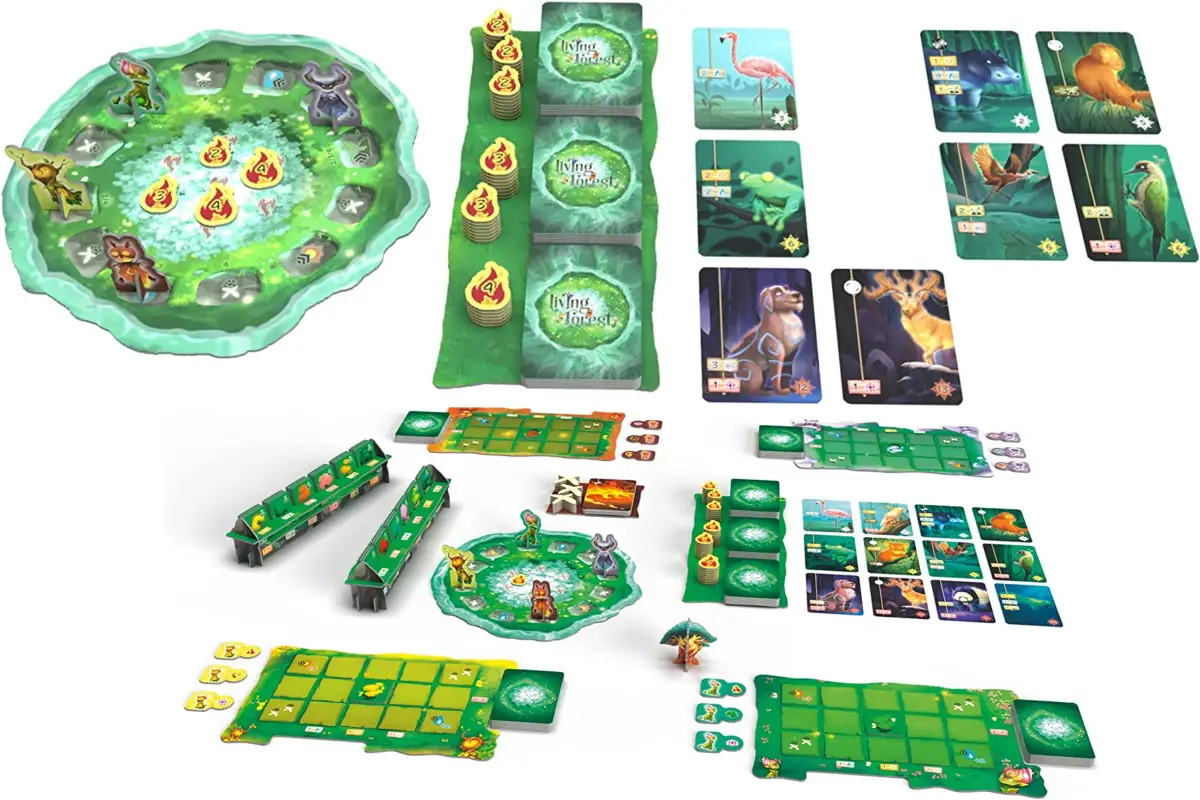
★★☆☆☆
For Families | Age: 8+ | 2-4 Players | Game Duration: 40 minutes
In Living Forest Board Game , players represent spirits of nature: Winter, Spring, Summer, or Autumn.
, players represent spirits of nature: Winter, Spring, Summer, or Autumn.
The goal is to save the Sacred Tree from the flames of Onibi (a deer). So, players take turn gathering a team of Guardian animals to protect the forest.
There are three ways to win the game:
- Assemble all 12 types of trees on the player board
- Gather 12 fire tokens
- Collect 12 items with lotus flower
Here’s a video of Bryan Drake explaining the rules of Living Forest Board Game .
.
Animal Board Games
The Alpha (Bicycle)
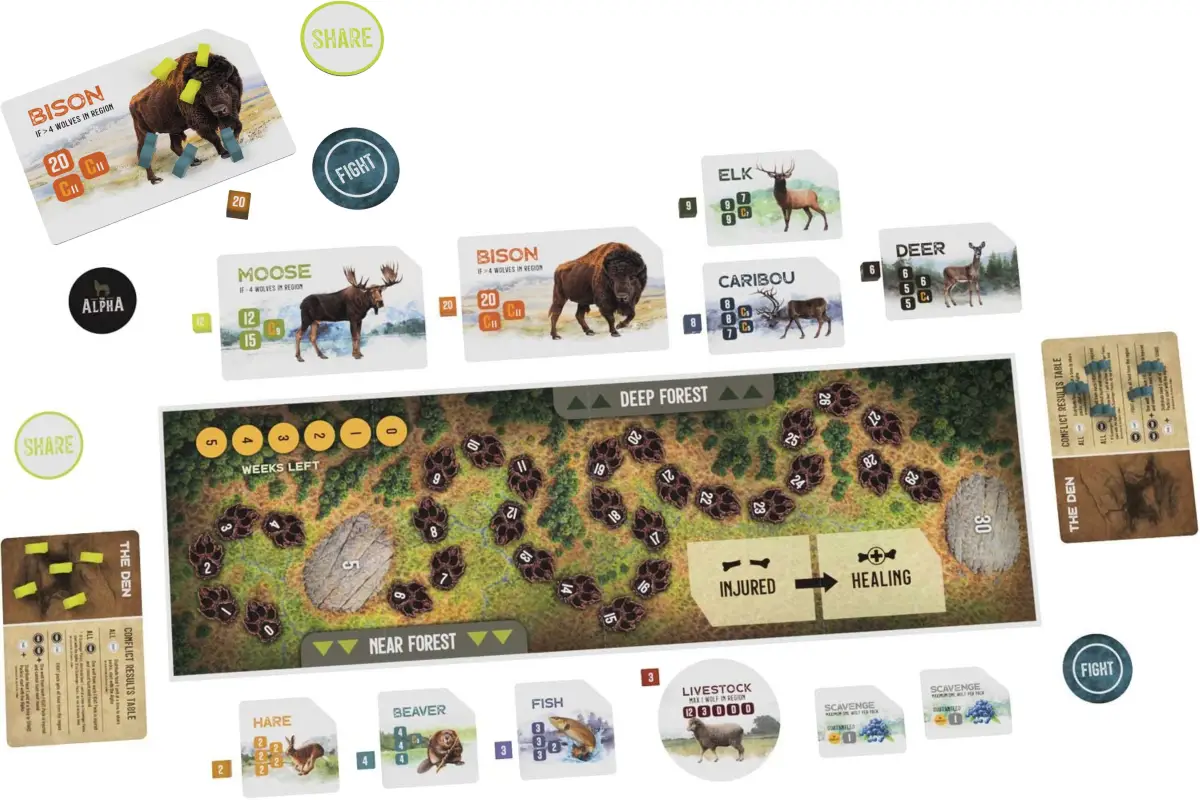
★★★☆☆
For Families | Age: 10+ | 3-6 Players | Game Duration: 20-45 minutes| Designer: Ralph Rosario
The Alpha is a strategy game where players lead a wolf pack to claim territories and hunt for food and prey. It includes 1 food track, 11 region tiles, 6 conflict tokens, 6 Alpha pair wolves, 36 beta wolves, 1 week token, 1 Alpha token, and 9 dice.
is a strategy game where players lead a wolf pack to claim territories and hunt for food and prey. It includes 1 food track, 11 region tiles, 6 conflict tokens, 6 Alpha pair wolves, 36 beta wolves, 1 week token, 1 Alpha token, and 9 dice.
The game has four stages:
- Stalk– Players send their wolves to claim territories.
- Chase– Players determine the fate of the hunt.
- Resolve– Players decide whether to fight rival packs or share food with them.
- Advance– Players record the amount of food secured .
This game is played over five rounds. The wolf pack with the most food at the end of the fifth round wins.
This competitive game is more entertaining with 6 players because of more interaction –sharing or fighting over food or territory. But, playing with 3 players is less brutal as there is minimal interaction when scoring points.
Look at this game overview and review of The Alpha by Tom Vasel.
Everdell (Starling Games)
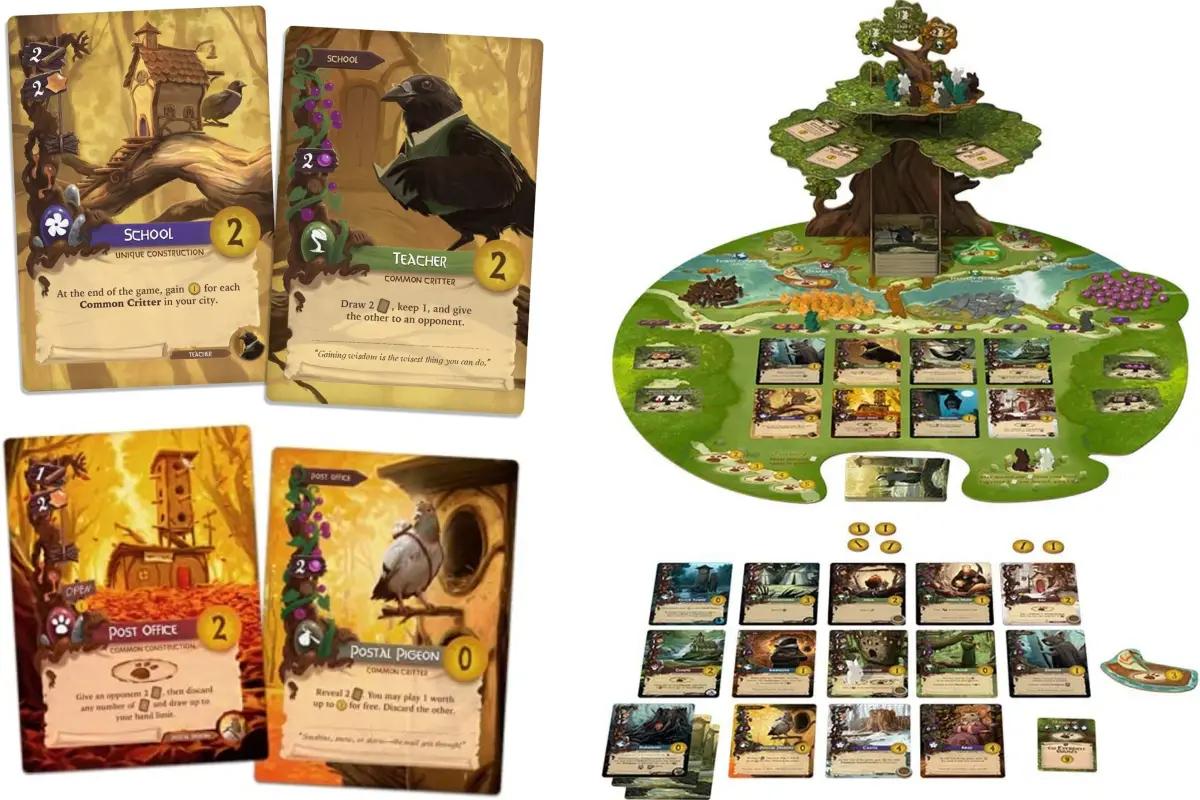
★★★☆☆
For Families | Age: 13+ | 1-4 Players | Game Duration: 40-80 minutes| Designer: James A. Wilson
Everdell is a tableau-building and worker placement game that starts at the tail-end of winter and ends before another winter begins.
is a tableau-building and worker placement game that starts at the tail-end of winter and ends before another winter begins.
Players take the role of the group leader of critters and assign tasks, including constructing buildings, hosting events, and recruiting characters. During each turn, players may:
- Place the workers to perform specific task to complete the tableau.
- Play a card to generate resources, abilities, and points.
- Replenish resources supply for the next season.
The player with the highest victory points wins the game.
The game’s main attraction is the huge tree at the center; however, it obstructs one’s way when playing with more than 3 players. Also, the tree takes time to be build and store.
But I still recommend this game because the game components are top-notch. Children will be fascinated with the beautiful artwork on the gameboard, tiles, and cards. They may also enjoy manipulating colorful game pieces.
You can check the rules of Everdell in this video of Rodney Smith from Watch it Played.
Hive (Gen42 Games)
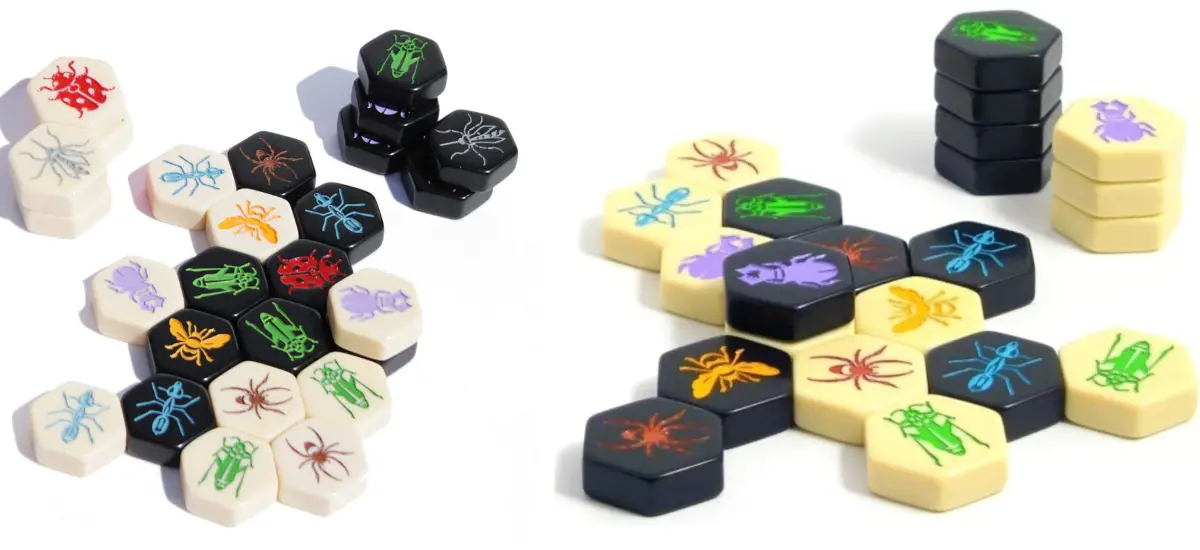
★★★☆☆
For Families | Age: 9+ | 2 Players | Game Duration: 20 minutes| Designer: John Yianni
Hive is a two-player strategy game, featuring 22 hexagon tiles inscribed with five different types of insects: ants, beetles, grasshoppers, spiders, and queen bees.
is a two-player strategy game, featuring 22 hexagon tiles inscribed with five different types of insects: ants, beetles, grasshoppers, spiders, and queen bees.
The aim is to surround the opponent’s queen bee with insects and prevent the other player’s from doing the same.
I like:
- The tiles are sturdy, smooth, and easy to use
- The interesting abilities of each insect, like:
- Ants– has the farthest movement in the game
- Grasshoppers– can hop on tiles in a straight line
- Spider- difficult to use because it moves three spaces around the hive
- Beetles-moves one space in any direction
Ryan Metzler broke down in his review the rules of Hive, so check this out.
Takenoko (Asmodee)

★★★☆☆
For Families | Age: 8+ | 2-4 Players | Game Duration: 45 minutes| Designer: Antoine Bauza
Takenoko is a light strategy game following the story of the Giant Panda given by the Emperor of China to the Emperor of Japan as a gesture of peace. The goal is to take care of the panda and tend a bamboo plantation.
is a light strategy game following the story of the Giant Panda given by the Emperor of China to the Emperor of Japan as a gesture of peace. The goal is to take care of the panda and tend a bamboo plantation.
Players compete in cultivating land plots, installing irrigation, and growing bamboo by rolling weather dice, drawing cards, and carefully placing tiles to achieve victory points. The player with the most points wins the game.
I like that:
- The game pieces are durable, colorful, and well-designed.
- Stacking bamboo pieces and moving the figures of the panda and the gardener are stimulating for children.
- There is a variety of actions and goals to complete in each turn, making the game highly replayable
You can learn more about Takenoko through this review of Tom Vasel.
Parks-themed Card Games
Monopoly National Parks (USAopoly)
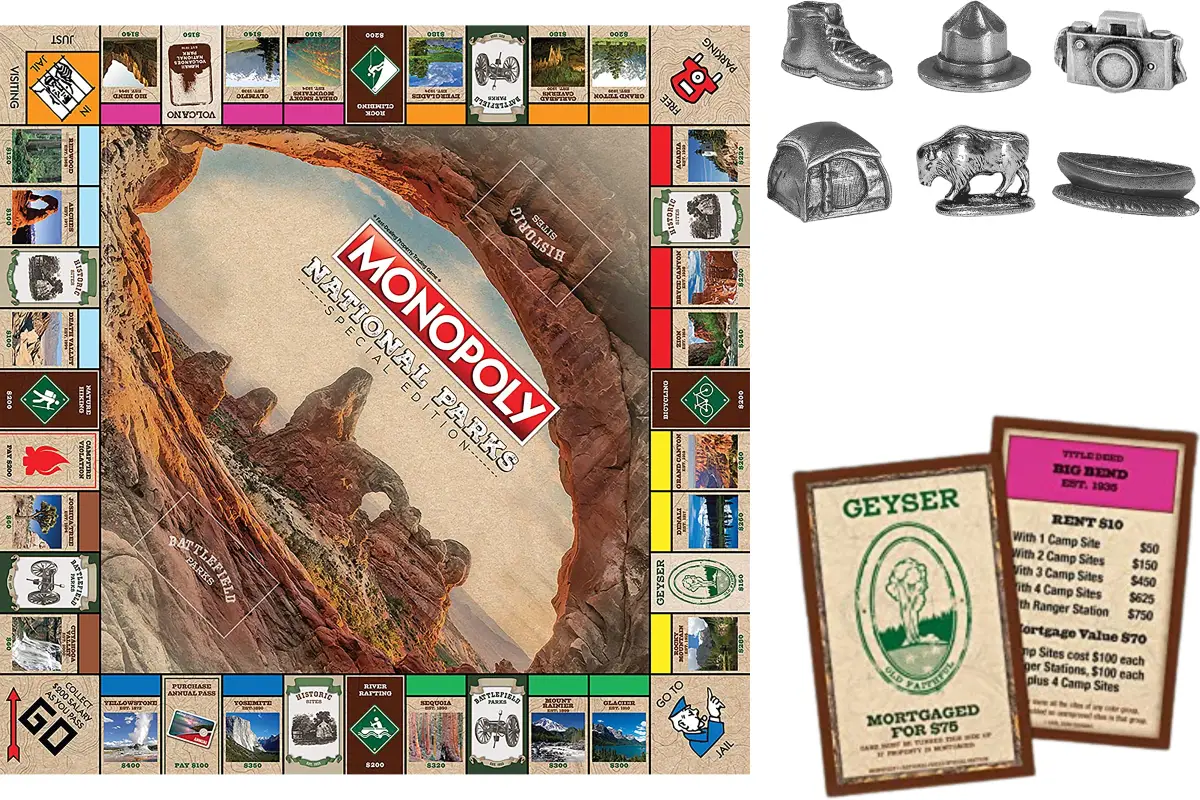
★★★★☆
For Families | Age: 8+ | 2-6 Players | Game Duration: 60-120 minutes
Monopoly National Parks features the 60 most historic sites in the US, like the Yellowstone, Grand Canyon, and Death Valley.
features the 60 most historic sites in the US, like the Yellowstone, Grand Canyon, and Death Valley.
Players collect US historic sites to build campsites and ranger stations. Then, they can lease trade or sell these properties to boost their income. The game also has historic site cards and battlefield park cards that affect players’ success.
The player with the highest value of properties when everyone else went bankrupt wins.
I like this game because:
- The game is easy to teach and play
- It features fun and custom game pieces: tent, hat, canoe, bison, hiking boot, and camera
I recommend this game because it is engaging and educational as the cards show images and information about the US national parks and historic sites.
Mountains (HABA)
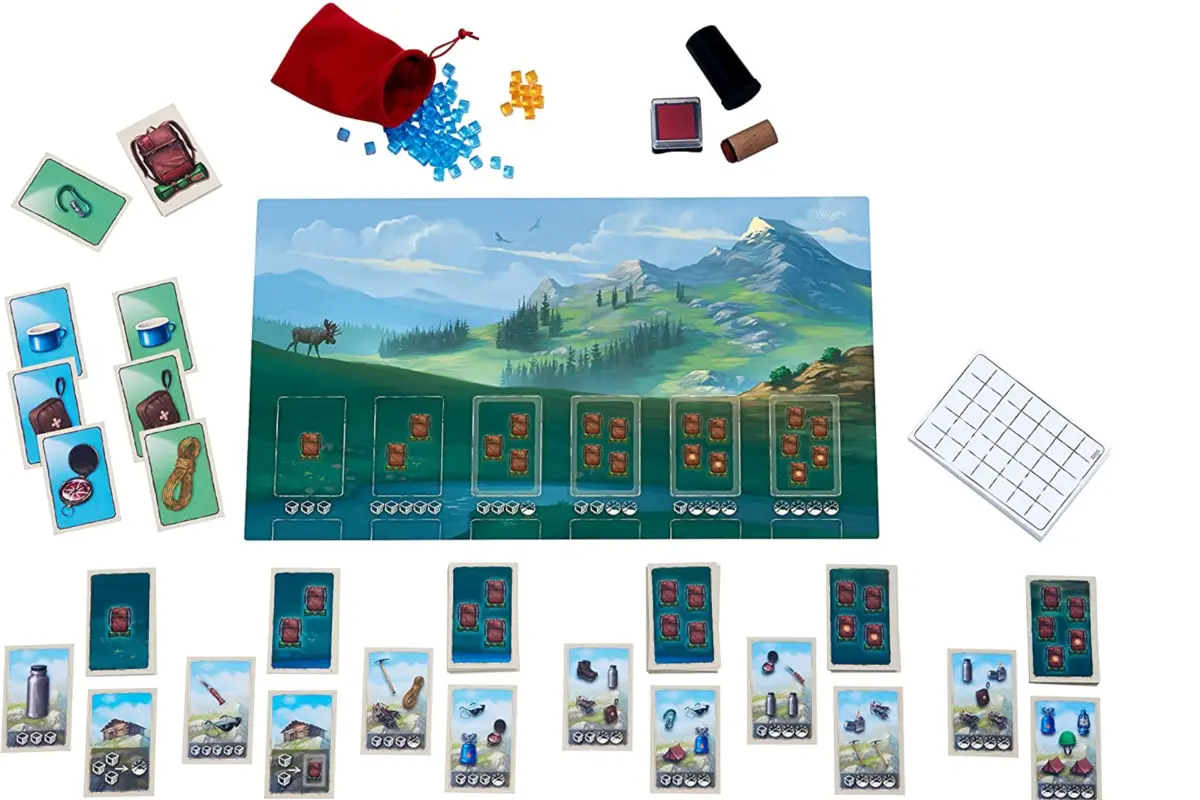
★★☆☆☆
For Families | Age: 8+ | 2-5 Players | Game Duration: 45 minutes| Designer: Carlo A. Rossi
Mountains is a strategy game where players prepare the equipment needed to reach the mountain’s summit.
is a strategy game where players prepare the equipment needed to reach the mountain’s summit.
Players compete to assemble as many equipment for as many hiking cards as they can. The game ends when two decks of difficult hiking cards are used up. And the player with the most stamps win.
I like the illustrations because they are neat, simple, and easy to understand. And I recommend Mountains because it is a good simulation game that can help children develop an interest in hiking.
because it is a good simulation game that can help children develop an interest in hiking.
Here is the official instructions video of Mountains .
.
Trails (Keymaster Games)
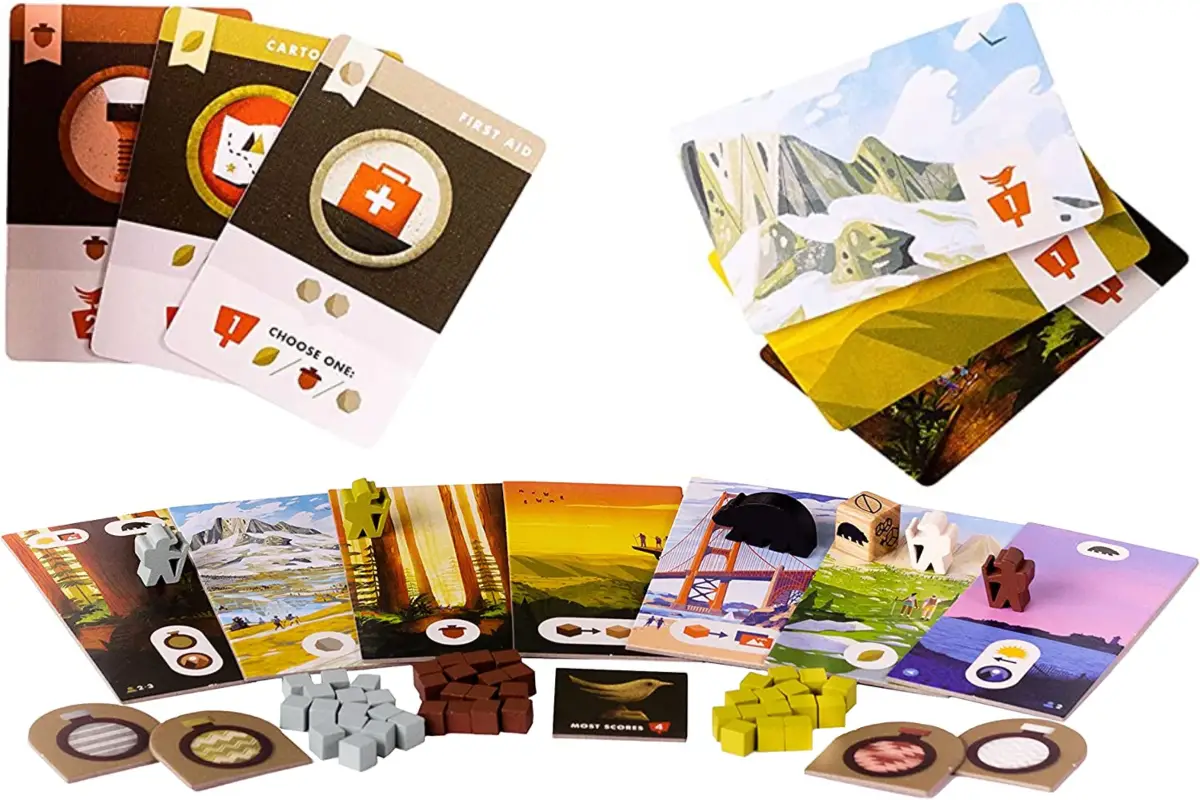
★★★☆☆
For Families | Age: 10+ | 2-4 Players | Game Duration: 20-40 minutes| Designer: Henry Audubon
Trails is a non-competitive card game, featuring famous national parks in the US. It comes with double-sided cards – day and night side, and colorful components like cubes, cards, player tokens, and dice.
is a non-competitive card game, featuring famous national parks in the US. It comes with double-sided cards – day and night side, and colorful components like cubes, cards, player tokens, and dice.
Players earn points by taking photos and collecting tokens as they hike along the trail. They also receive bonus points for every wildlife encountered during the hike. Once they reach the end of the trail, they flip the cards to reveal the night side and travel back to the beginning. The player with the most points is the winner.
I like this game because it takes about 10 minutes to learn and less than 40 minutes to play. The illustrations are beautiful. And I recommend this game because it is not competitive but challenging enough if you like set collection games.
In this video, Tom Vasel shares the rules and his review of Trails .
.
Parks (Keymaster Games)
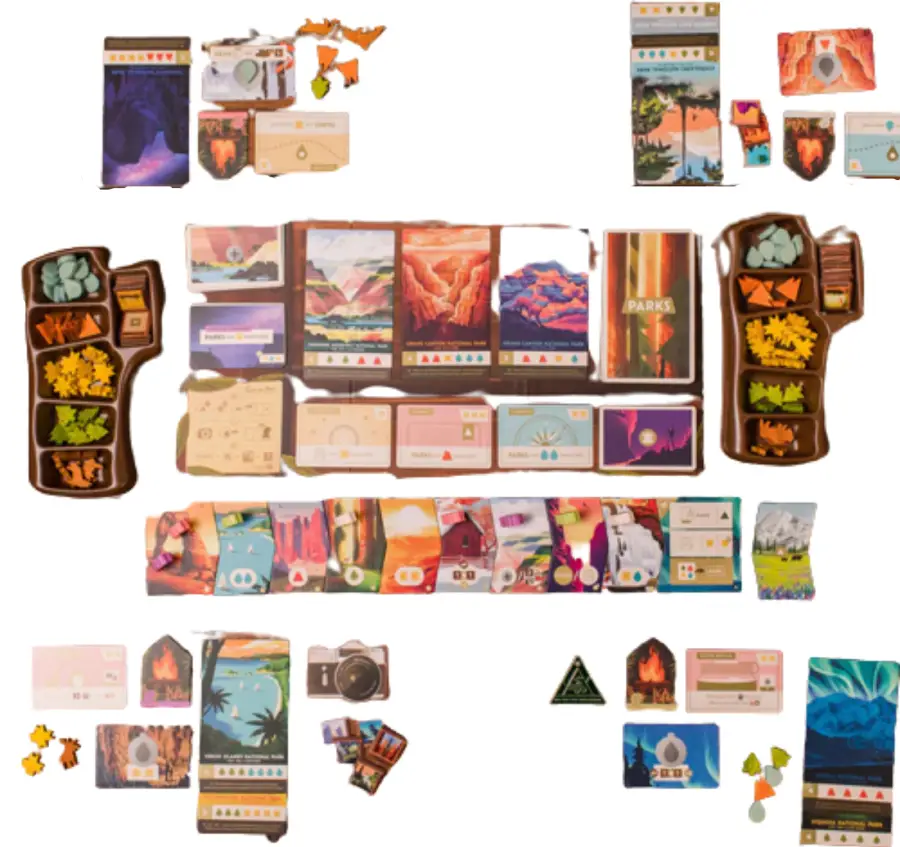
★★★☆☆
For Families | Age: 10+ | 1-5 Players |Game Duration: 30-60 minutes | Designer: Henry Audubo
Parks is another strategy card game from Keymaster Games and is played over four seasons instead of a day and night.
is another strategy card game from Keymaster Games and is played over four seasons instead of a day and night.
Similar to Trails, players travel the paths and collect tokens. These tokens can also be used to gather equipment and visit national parks. The game ends after four rounds, and the player with the most points wins.
I recommend this game because it offers replayability. The cards and trails change every game, so you always get a new experience. It is also relaxing game to play solo and becomes strategic with 2-5 players. Lastly, I like the beautiful artwork and quality of the game components.
You can learn more about Parks in this game overview by BoardGame Teacher.
in this game overview by BoardGame Teacher.
3 Nature-themed Card Games
Arboretum (Renegade Game Studios)
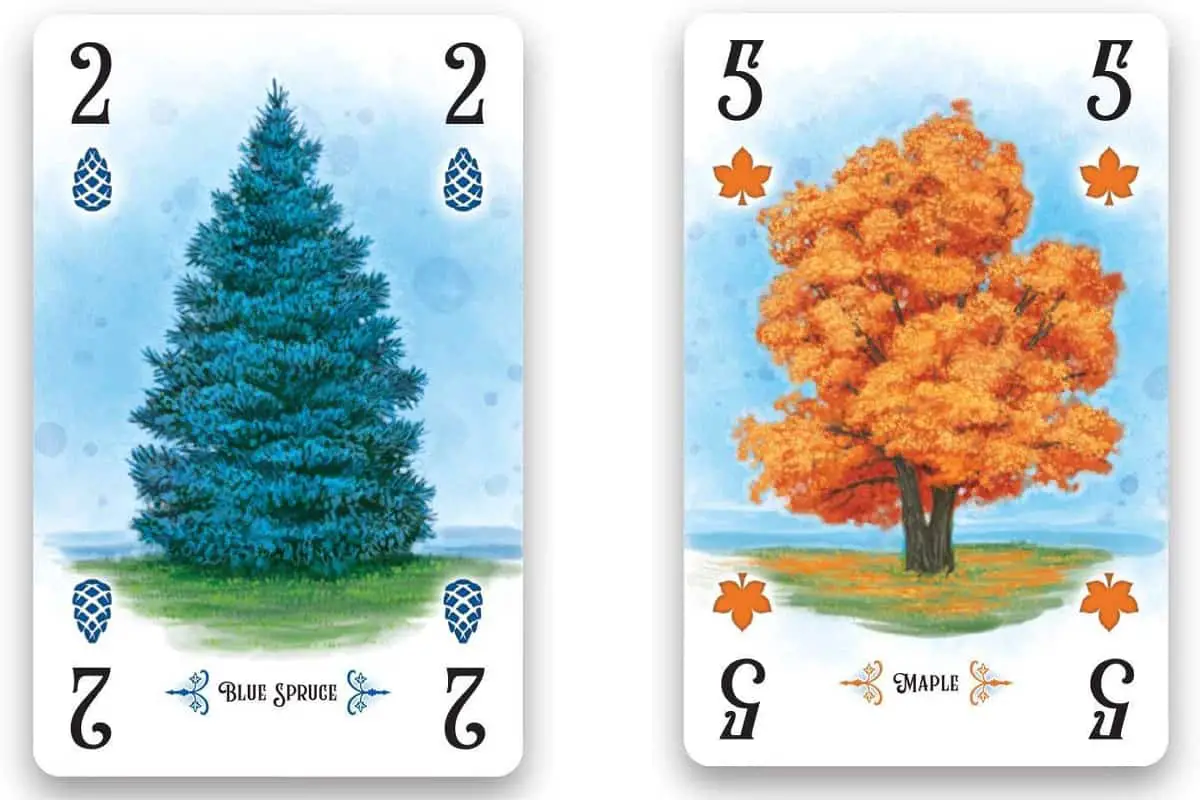
★★★☆☆
For Families | Age: 8+ | 2-4 Players | Game Duration: 30 minutes | Designer: Dan Cassar
Arboretum is a 30-minute strategy game where players design a beautiful garden path for visitors. The game contains 80 cards that teach children 10 different types of trees, such as:
is a 30-minute strategy game where players design a beautiful garden path for visitors. The game contains 80 cards that teach children 10 different types of trees, such as:
- Maple
- Cassia
- Dogwood
- Blue Spruce
- Cherry Blossom
- Royal Poinciana
Players take turns carefully arranging the trees in their botanical garden to score points.
They earn them if:
- The tree path begins and ends in the same tree (the cards have labels)
- The trees are arranged in ascending order (the cards are numbered 1-8)
The player with the most points when the deck is finished is the winner.
I recommend this game because
- the rules are easy to follow
- the illustrations are visually appealing and easy to remember
Here’s Tom Vasel’s review of Arboretum for other interesting details.
Canopy (Greater Than Games)
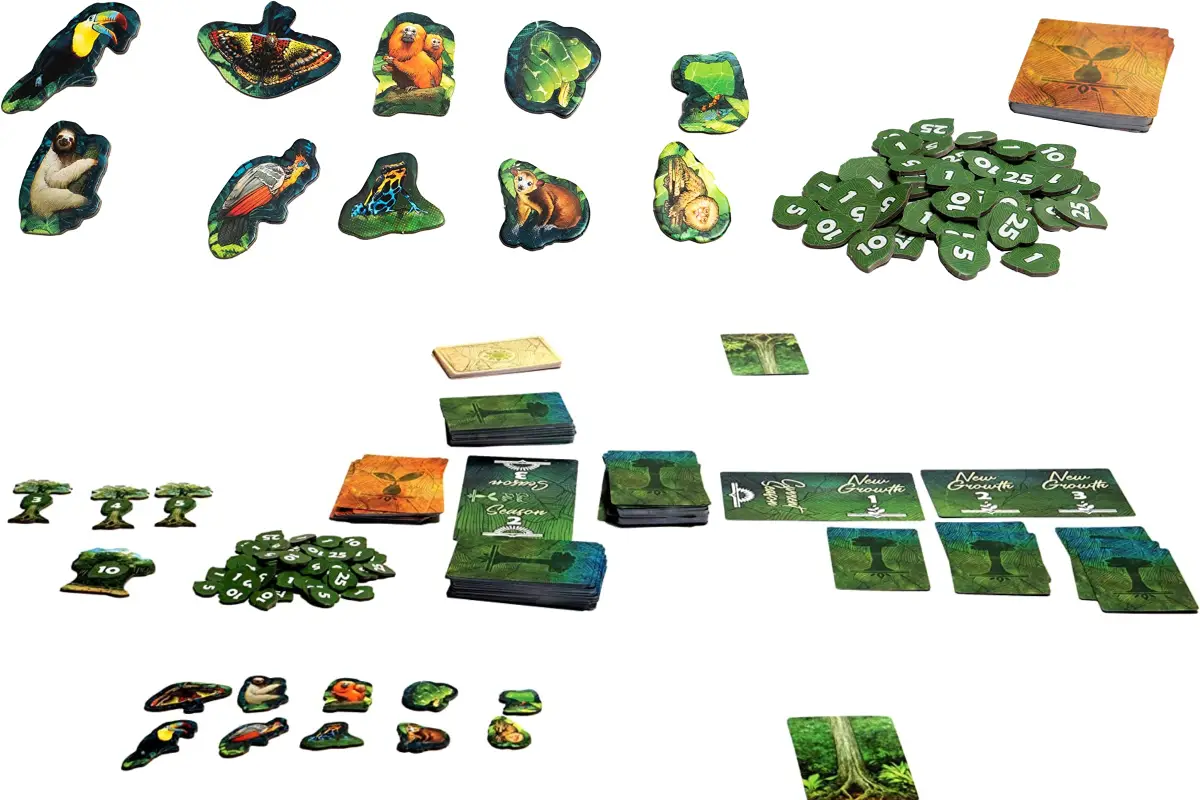
★★★☆☆
For Families | Age: 8+ | 1-4 Players | Game Duration: 30 minutes| Designer: Tim Eisner
Canopy teaches children 25 unique species of rainforest animals and plants and their symbiotic relationships.
teaches children 25 unique species of rainforest animals and plants and their symbiotic relationships.
Players take turns drawing cards to grow trees and fill their forests with wildlife over three seasons. Like in a typical forest, they may also encounter dangers, like:
- fire
- disease
- drought
The player with the highest victory points at the end of three growth rounds is the winner.
I like this game because of the excellent card quality, which features plant and animal names and images. Also, itcan be played in either solo mode or with up to 4 players.
Graeme Anderson shows how to play Canopy in his video.
Life on Earth Memory and Matching Game (Eebo)
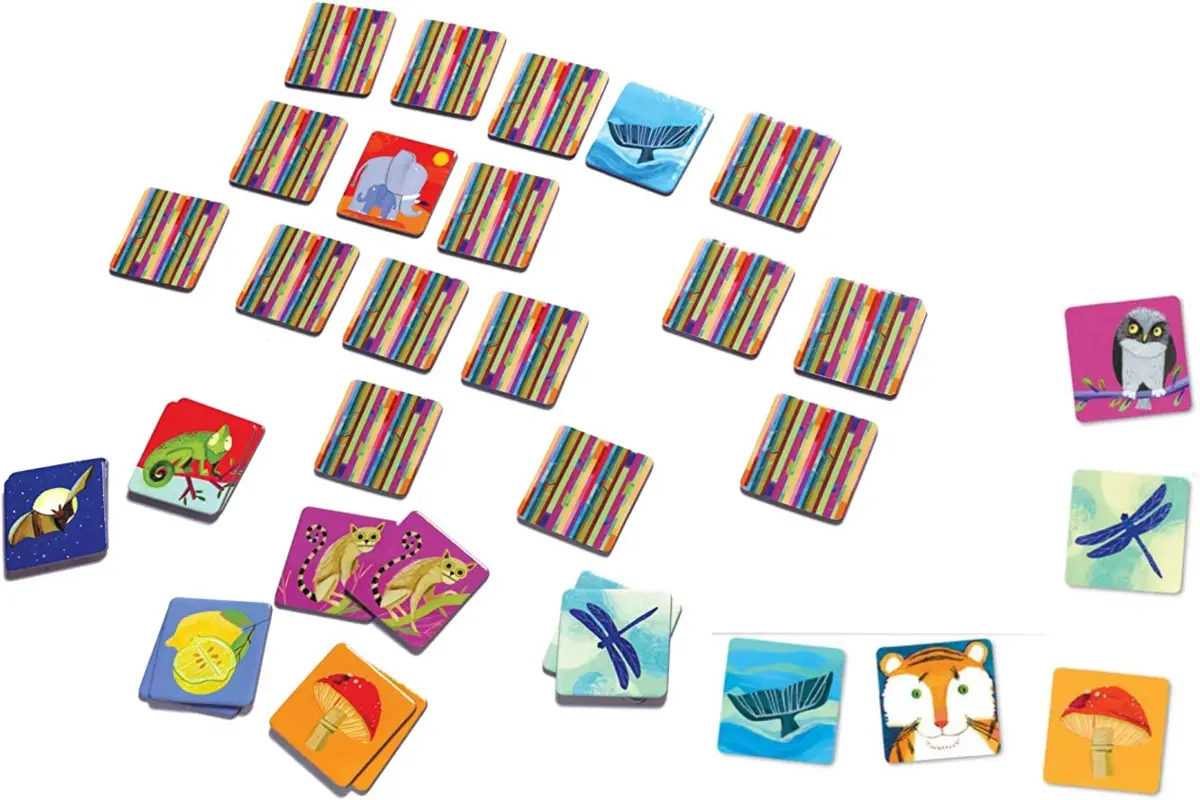
★★☆☆☆
For Families | Age: 3+ | 2-6 Players | Game Duration: 10-20 minutes
Life on Earth Memory and Matching Game features 24 pairs of colorfully illustrated cards, showing different plants and animals. The cards are also made of thick cardboard, so they are durable and easy-to-use for young children.
I recommend this memory and matching game to children aged 3 and up because the gameplay is simple but fun. However, it has low replayability as there are only 24 matches.
Kodama (Publisher Services Inc)

★★☆☆☆
For Families | Age: 14+ | 2-5 Players | Game Duration: 30 minutes | Designer: Daniel Solis
Kodama is a tree-building game where players act as caretakers of tree spirits called Kodama. The goal is to make the right branch arrangements over three seasons.
is a tree-building game where players act as caretakers of tree spirits called Kodama. The goal is to make the right branch arrangements over three seasons.
Each player gets a three base, and they get four turns in each round to attach branches to it. There are three rounds, and the person with the highest points at the end wins.
I like this game because the tree you grow differs in the strategy you use each. But there is a learning curve to learning to play and scoring the game. It also requires a huge playing space.
Here’s a demonstration of Kodama by Rodney Smith of Watch it Played.
by Rodney Smith of Watch it Played.
Strawberry Sunset (Stellar Factory)

★★★☆☆
For Families | Age: 7+ | 2-4 Players |Game Duration: 10-20 minutes
In Strawberry Sunset , players have until sunset to grow as many strawberries as they can. This game contains 56 cards drawn in three stages: sunrise, noon, and sunset. The cards are neat and attractive but slippery.
, players have until sunset to grow as many strawberries as they can. This game contains 56 cards drawn in three stages: sunrise, noon, and sunset. The cards are neat and attractive but slippery.
To play, players have to align the cards to previously place ones. They earn points when they connect roots, flowers, or fruits. They get additional points for water features and stone paths and lose points if there are gravel parts. The game ends when the deck runs out. The person with the highest points is the winner.
I recommend Strawberry Sunset because it is easy to play but hard to master, so it has high replayability.
because it is easy to play but hard to master, so it has high replayability.
Other Types of Plant Games
If you would like to introduce your child to gardening, farming, or naming plants, you might want to check my post, “16 Botanical Board and Card Games for Families and School”.
Edudingo.com is a participant in the Amazon Services LLC Associates Program, an affiliate advertising program designed to provide a means for sites to earn advertising fees by advertising and linking to Amazon.com. We also participate in other affiliate programs which compensate us for referring traffic.

